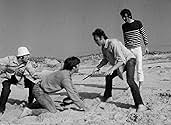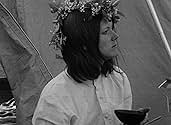A teen joins friends on Fire Island for summer where they have various sexual encounters. She seduces her brother then they try to influence their parents' views.A teen joins friends on Fire Island for summer where they have various sexual encounters. She seduces her brother then they try to influence their parents' views.A teen joins friends on Fire Island for summer where they have various sexual encounters. She seduces her brother then they try to influence their parents' views.
Photos
- Director
- Writers
- All cast & crew
- Production, box office & more at IMDbPro
Storyline
Did you know
- TriviaThis long-lost film is now discovered by Vinegar Syndrome Company, as the complete version is still unknown thus is pending on researching and restoration the film for Blu-ray release directly from that company.
- ConnectionsFeatured in Twisted Sex Vol. 6
Featured review
It's the Year of the Cock, 1969, an opening title card proclaims. Set on Fire Island, New York, free love reigns in BARBARA, as couples disrobe, fornicate, and talk about sex incessantly. This is an early semi-pornographic film shot in a documentary style that is intended to illustrate and explain the sexual revolution and youth rebellion ideologies of the era.
BARBARA attempts to navigate the complexities of coming of age, societal critique, and the pursuit of sexual expression through a myriad of partnerships. A motley crew of young people gathers around Max (Jack Rader), an older island inhabitant who positions himself as a kind of guru of sexual liberation, advocating for a lifestyle of unrestricted sexual encounters as a path to freedom.
The weak narrative weaves through the superficial relationships between Max, his shallow girlfriend Barbara, and a visiting couple, Leslie and Tom, serving primarily as a backdrop for the actors' unabashed nudity and combination of simulated and unsimulated sex. The dialogue, seemingly improvised, is laden with the era's counter-culture clichés, exploring themes of sexual liberation, the intertwining of sex and spirituality, and even touching upon anti-Vietnam War sentiments, all under the guise of expanding the characters' emotional and physical experiences.
Influenced by the French New Wave of the Sixties, BARBARA is stylistically ambitious, employing grainy black-and-white cinematography and occasional inter-titles to convey characters' thoughts or narrative progression, though its artistic endeavors often obscure the on-screen action. The film also draws from the "roughies" genre prevalent in adult cinemas of the 1960s, incorporating elements of non-consensual sex and a suggestion of bestiality.
Released in theaters in August 1970, BARBARA stands among the pioneering films of its time that ventured into the realm of explicit sexual content, alongside early adult films like MONA THE VIRGIN NYMPH and ANDY WARHOL'S BLUE MOVIE. Director Walter Burns sought to advance the cinematic portrayal of sexuality, amalgamating various contemporary themes in an attempt to resonate with the intended audience. However, the film's effort to align with the progressive attitudes of its time ultimately falls short, rendering it pretentious and more superficial than insightful.
BARBARA attempts to navigate the complexities of coming of age, societal critique, and the pursuit of sexual expression through a myriad of partnerships. A motley crew of young people gathers around Max (Jack Rader), an older island inhabitant who positions himself as a kind of guru of sexual liberation, advocating for a lifestyle of unrestricted sexual encounters as a path to freedom.
The weak narrative weaves through the superficial relationships between Max, his shallow girlfriend Barbara, and a visiting couple, Leslie and Tom, serving primarily as a backdrop for the actors' unabashed nudity and combination of simulated and unsimulated sex. The dialogue, seemingly improvised, is laden with the era's counter-culture clichés, exploring themes of sexual liberation, the intertwining of sex and spirituality, and even touching upon anti-Vietnam War sentiments, all under the guise of expanding the characters' emotional and physical experiences.
Influenced by the French New Wave of the Sixties, BARBARA is stylistically ambitious, employing grainy black-and-white cinematography and occasional inter-titles to convey characters' thoughts or narrative progression, though its artistic endeavors often obscure the on-screen action. The film also draws from the "roughies" genre prevalent in adult cinemas of the 1960s, incorporating elements of non-consensual sex and a suggestion of bestiality.
Released in theaters in August 1970, BARBARA stands among the pioneering films of its time that ventured into the realm of explicit sexual content, alongside early adult films like MONA THE VIRGIN NYMPH and ANDY WARHOL'S BLUE MOVIE. Director Walter Burns sought to advance the cinematic portrayal of sexuality, amalgamating various contemporary themes in an attempt to resonate with the intended audience. However, the film's effort to align with the progressive attitudes of its time ultimately falls short, rendering it pretentious and more superficial than insightful.
- jfrentzen-942-204211
- Feb 10, 2024
- Permalink
Details
- Runtime1 hour 31 minutes
- Color
- Sound mix
- Aspect ratio
- 1.37 : 1
Contribute to this page
Suggest an edit or add missing content















